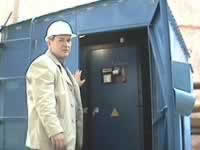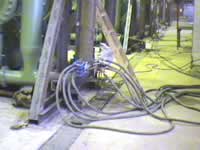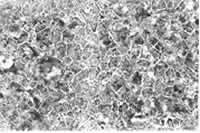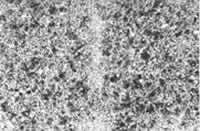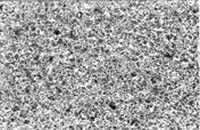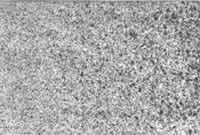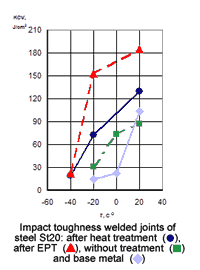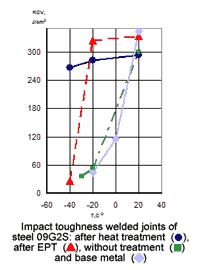| |
Application.
The device DS10D is intended for releasing of residual stresses, improvement of weldment characteristics and can be used for manufacturing and repairs of pipelines, vessels and other systems in chemical and metallurgical industries, shipbuilding, etc. The technology based on DS10D apparatus completely replaces after-welding heat treatment of parts with the wall thickness up to 40 mm. As far as the treatment efficiency, it is several times higher than with conventional technology.
New method allows significantly improve the metal properties.
The Technological Principles.
Manufacturing processes are the most common causes of residual stress. Virtually all manufacturing and fabricating processes -- casting, welding, machining, molding, heat treatment, etc. -- introduce residual stresses into the manufactured object.
Residual stresses always appear in welded articles. If not treated, they can lead to the structural damage.
Heat treatment allows to lessen residual stresses and to improve structural uniformity. The most common methods are general heat treatment or localized heat with applied heating devices.
High power consumption and long make conventional heat treatment procedure a quite expensive task, especially for large elements.
In some case ultrasonic, vibration or other methods can be utilized, but their application is limited, and they are marked by low efficiency.
DS Co.Ltd. has developed technology and equipment (DS10D) for releasing of residual stresses and improvement characteristics of weldment. The technology completely replaces after-welding heat treatment of welding parts.
New technology utilizes impulses of changing electric current running through the weldment .
The impulses of current are controlled under the program supporting by microprocessor of the DS10D apparatus. Unlike in the conventional method, electro-physical treatment (EPT) of weldment leads to the microstructure transformation at lower temperatures. This phenomenon occurs when high-energy electric and magnetic fields are applied to the weldment that leads to interaction of conductivity electrons and metal microstructure. Thus accelerates movement of dislocations and relaxation residual stress in crystals in consequence of mechanical and electronic forces. The depth of relaxation residual stresses depends from the number of impulses.
After EPT the mechanical properties and yield characteristics structural and low-carbon steels weldments are on à level of base material, but the increasing impact toughness up to 40% in comparison with heat treatment.
The technology is especially effective for treatment of large parts, which with the conventional technology require after weld heat treatment. Sections of weldment processed, one after another. For particular customer applications develops a Standard Operation Procedure and optimizes process parameters.
The DS10D apparatus and EPT technology are tested and confirmed by Institute of Electric Welding named after Å.Î.Paton NAS of Ukraine.
Electro-physical treatment of weldment is an effective method for improvement of reliability of welded parts and their service life.
The equipment is designed for use in under normal industrial conditions; for fieldwork it is housed in a specially designed weather-proof cabinets.
Structure of the DS10D apparatus.
DS10D apparatus has control panel, connecting cables and contacts.
All control devices, indicators, switches, etc. are housed in the control panel, with all process parameters displayed. Controllable current source is also located inside the cabinet.
Power transformer and a thyristor voltage regulator are located in the bottom part of control cabinet. Microprocessor and power source are in the upper part.
Power rectifier diodes, cooling unit and reverse block are placed in the backside of control cabinet.
The treatment process is carried out under 30 v; it meets all safety requirements and regulations.
Welded part is connected to the apparatus by means of connecting cable with specially designed contacts.
Connection points and process parameters are determined after developing the procedure based on part final specifications. Process parameters are optimized according to the results of x-ray analysis and mechanical testing.
Process parameters are input in microprocessor in a dialog mode.
Password is used In order to prevent non-authorized parameters change or input.
Sophisticated software package monitors the process and guarantees adherence to the input parameters. Memory block contains up to 8 sets of process instructions. After the startup the system operates in an automated mode. All process parameters are displayed and plotted.
The equipment is designed for use in under normal industrial conditions; for fieldwork it is housed in a specially designed weather-proof cabinets.
The Characteristics Of Òhe Apparatus:
| Range of amplitude unipolar current impulses, êÀ |
from 0.1 up 10.0 |
| Output voltage, nî more, V |
30 |
| Sets of process instructions, mode |
8 |
| Current adjustment range, % |
3-5 |
|
Time of one operation cycle, min.
|
15-20 |
|
Input power per cycle, êW•h
|
10-14 |
| Prime voltage ~3, 50 Hz, V |
380 ± 20 |
| Dimensions, mm
- length
- width
- height
|
900
1200
1930
|
| Weight (without cable), kg |
960 |
The patent of Ukraine ¹43290A. The device DS10D is certificated in à system UkrSEPRO ¹ UA1.146.19804-01. Technology of electrophysical treatment and device DS10D are approved by Gosnadzorohrantruda îf Ukraine
|
